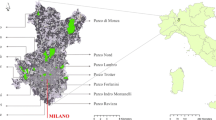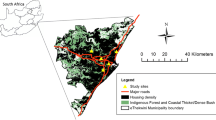Abstract
As urbanization accelerates, urban biodiversity conservation is becoming a great concern for the maintenance of urban ecosystem functions. In particular, forest bird communities in urban areas have been recognized as a conservation target because of their functions in food webs and ecosystem services. But our understanding of which local- and landscape-scale factors influence native bird communities within urban green spaces is still insufficient to provide managers with information for effectively planning biodiversity management programs. Here we examine how local habitat characteristics, human disturbance, and habitat connectivity influence the diversity of forest bird communities in 44 small forest patches (0.5–20.0 ha) embedded in an urbanized landscape. Patch size exerted a positive influence on the diversity of most bird functional groups, and it had the greatest effects on total abundance and species richness. The second most important factor was human disturbance. Remnant patches with lower levels of human disturbance had higher diversity than newly established patches where intense human activities occurred more frequently. In addition, vegetation complexity and habitat connectivity were positively related to total species richness and abundance, respectively, but they were less important. Management strategies for the conservation of urban forest birds, therefore, should consider not only local improvements in habitat structure – through increased patch size, reduced human disturbance, and increased vegetation complexity – but also the maintenance of habitat connectivity.


Similar content being viewed by others
References
Alvey AA (2006) Promoting and preserving biodiversity in the urban forest. Urban For Urban Green 5:195–201
Andren H (1994) Effects of habitat fragmentation on birds and mammals in landscapes with different proportions of suitable habitat: a review. Oikos 71:355–366
Barton K (2014) MuMIn: multi-model inference. R Package Version 1.10.5. R Foundation for Statistical Computing, Vienna, Austria, http://cran.r-project.org/web/packages/MuMIn/index.html. Accessed 11 Sep 2014
Bibby CJ, Burgess ND, Hill DA, Mustoe SH (2000) Bird census techniques, 2nd edn. Academic Press, London
Blumstein DT, Fernández-Juricic E, Zollner PA, Garity SC (2005) Inter-specific variation in avian responses to human disturbance. J Appl Ecol 42:943–953. doi:10.1111/j.1365-2664.2005.01071.x
Bodin Ö, Saura S (2010) Ranking individual habitat patches as connectivity providers: integrating network analysis and patch removal experiments. Ecol Model 221:2393–2405. doi:10.1016/j.ecolmodel.2010.06.017
Brooker L, Brooker M, Cale P (1999) Animal dispersal in fragmented habitat: measuring habitat connectivity, corridor use, and dispersal mortality. Conserv Ecol 3:4
Bunn A, Urban D, Keitt T (2000) Landscape connectivity: a conservation application of graph theory. J Environ Manag 59:265–278
Burnham K, Anderson D (2002) Model selection and multimodel inference: a practical information-theoretic approach. Springer, New York
Burr RM, Jones R (1968) The influence of parkland habitat management on birds in Delaware. T N Am Wildl Nat Res 33:299–306
Carbó-Ramírez P, Zuria I (2011) The value of small urban greenspaces for birds in a Mexican city. Landsc Urban Plann 100:213–222
Chambers JM, Hastie TJ (1992) Statistical models in S. Chapman and Hall, London
Chevan A, Sutherland M (1991) Hierarchical partitioning. Am Stat 45:90–96
Choi CY, Nam HY, Hur WH, Lee WS, Kim HJ, Hwang GY (2006) Edge preference of forest-dwelling birds in the temperate deciduous forests. J Ecol Field Biol 29:191–203 (in Korean with English abstract)
Devictor V, Julliard R, Couvet D, Lee A, Jiguet F (2007) Functional homogenization effect of urbanization on bird communities. Conserv Biol 21:741–751
Drinnan IN (2005) The search for fragmentation thresholds in a southern Sydney suburb. Biol Conserv 124:339–349
Evans KL, Newson SE, Gaston KJ (2009) Habitat influences on urban avian assemblages. Ibis 151:19–39
Fahrig L (2001) How much habitat is enough? Biol Conserv 100:65–74
Fernández-Juricic E (2000a) Avifaunal use of wooded streets in an urban landscape. Conserv Biol 14:513–521
Fernández-Juricic E (2000b) Local and regional effects of pedestrians on forest birds in a fragmented landscape. Condor 102:247–255
Fernández-Juricic E (2004) Spatial and temporal analysis of the distribution of forest specialists in an urban-fragmented landscape (Madrid, Spain): implications for local and regional bird conservation. Landsc Urban Plann 69:17–32
Fernández-Juricic E, Jokimäki J (2001) A habitat island approach to conserving birds in urban landscapes: case studies from southern and northern Europe. Biodivers Conserv 10:2023–2043
Fernández-Juricic E, Tellería JL (2000) Effects of human disturbance on spatial and temporal feeding patterns of Blackbird Turdus merula in urban parks in Madrid, Spain. Bird Study 47:13–21
Forman RTT (2014) Urban ecology: science of cities. Cambridge University Press, Cambridge
Gaston KJ (2010) Valuing common species. Science 327:154–155
Gonzalez A, Lawton J, Gilbert F, Blackburn T, Evans-Freke I (1998) Metapopulation dynamics, abundance, and distribution in a microecosystem. Science 281:2045–2047
Haas CA (1995) Dispersal and use of corridors by birds in wooded patches on an agricultural landscape. Conserv Biol 9:845–854
Husté A, Selmi S, Boulinier T (2006) Bird communities in suburban patches near Paris: determinants of local richness in a highly fragmented landscape. Ecoscience 13:249–257
Ikuta LA, Blumstein DT (2003) Do fences protect birds from human disturbance? Biol Conserv 112:447–452
Johnston RF (2001) Synanthropic birds of North America. In: Marzluff JM, Bowman R, Donnelly RE (eds) Avian ecology and conservation in an urbanizing world. Kluwer Academic, Norwell, Massachusetts, pp 49–67
Joshi KK, Bhatt D, Thapliyal A (2012) Avian diversity and its association with vegetation structure in different elevational zones of Nainital district (Western Himalayan) of Uttarakhand. Int J Biodivers Conserv 4:364–376
Karr JR, Roth RR (1971) Vegetation structure and avian diversity in several New World areas. Am Nat 105:423–435
Kim J (2003) Forest fragmentation effects from urban expansion in Seoul and its satellite cites. Master degree thesis, Seoul National University (in Korean with English abstract)
Kong F, Yin H, Nakagoshi N (2007) Using GIS and landscape metrics in the hedonic price modeling of the amenity value of urban green space: a case study in **an City, China. Landsc Urban Plann 79:240–252
Korea Forest Service (KFS) (2012) Statistical yearbook of forestry. 468 p (in Korean)
Korean Statistical Information Service (KSIS) (2005) The 2005 population and housing census of Korea (in Korean)
Koskimies P (1989) Birds as a tool in environmental monitoring. Ann Zool Fenn 26:153–166
Lancaster RK, Rees WE (1979) Bird communities and the structure of urban habitats. Can J Zool 57:2358–2368
Lee W, Park C-R (1995) Analysis of changes on the forest environment and the bird community in terms of guild. Korean J Environ Ecol 18:397–408 (in Korean with English abstract)
Legendre P, Dale MR, Fortin MJ, Gurevitch J, Hohn M, Myers D (2002) The consequences of spatial structure for the design and analysis of ecological field surveys. Ecography 25:601–615
Legendre P, Legendre L (1998) Numerical ecology. 2nd english edn. Elsevier Science, Amsterdam
Lyons KG, Brigham CA, Traut BH, Schwartz MW (2005) Rare species and ecosystem functioning. Conserv Biol 19:1019–1024. doi:10.1111/j.1523-1739.2005.00106.x
Mac Nally R (2002) Multiple regression and inference in ecology and conservation biology: further comments on identifying important predictor variables. Biodivers Conserv 11:1397–1401
Martensen AC, Pimentel RG, Metzger JP (2008) Relative effects of fragment size and connectivity on bird community in the Atlantic Rain Forest: implications for conservation. Biol Conserv 141:2184–2192. doi:10.1016/j.biocon.2008.06.008
Melles S, Glenn S, Martin K (2003) Urban bird diversity and landscape complexity: species-environment associations along a multiscale habitat gradient. Conserv Ecol 7:5
Millennium Ecosystem Assessment (MA) (2005) Ecosystems and human well-being. Island Press
Miller JR, Cale P (2000) Behavioral mechanisms and habitat use by birds in a fragmented agricultural landscape. Ecol Appl 10:1732–1748
Minor E, Urban D (2010) Forest bird communities across a gradient of urban development. Urban Ecosyst 13:51–71
O'Connell TJ, Jackson LE, Brooks RP (2000) Bird guilds as indicators of ecological condition in the central Appalachians. Ecol Appl 10:1706–1721. doi:10.1890/1051-0761(2000)010[1706:bgaioe]2.0.co;2
Park CR, Lee WS (2000) Relationship between species composition and area in breeding birds of urban woods in Seoul, Korea. Landsc Urban Plann 51:29–36
Purevdorj T, Tateishi R, Ishiyama T, Honda Y (1998) Relationships between percent vegetation cover and vegetation indices. Int J Remote Sens 19:3519–3535
R Core Team (2013) R: a language and environment for statistical computing. R Foundation for Statistical Computing, Vienna, Austria. http://www.R-project.org/. Accessed 11 Sep 2014
Roberts D (2013) Labdsv: ordination and multivariate analysis for ecology. R package version 1.6-1. R Foundation for Statistical Computing, Vienna, http://cran.r-project.org/web/packages/labdsv/index.html. Accessed 11 Sep 2014
Sadler J, Bates A, Hale J, James P (2010) Bringing cities alive: the importance of urban green spaces for people and biodiversity. In: Gaston KJ (ed) Urban ecology. Cambridge University Press, Cambridge, pp 230–260
Saura S, Pascual-Hortal L (2007) A new habitat availability index to integrate connectivity in landscape conservation planning: comparison with existing indices and application to a case study. Landsc Urban Plann 83:91–103
Saura S, Rubio L (2010) A common currency for the different ways in which patches and links can contribute to habitat availability and connectivity in the landscape. Ecography 33:523–537
Seoul Metropolitan Government (SMG) (2010) The city biotope map of Seoul, Korea
Shanahan DF, Miller C, Possingham HP, Fuller RA (2011) The influence of patch area and connectivity on avian communities in urban revegetation. Biol Conserv 144:722–729. doi:10.1016/j.biocon.2010.10.014
Shwartz A, Muratet A, Simon L, Julliard R (2013) Local and management variables outweigh landscape effects in enhancing the diversity of different taxa in a big metropolis. Biol Conserv 157:285–292
Statistics Korea (KOSTAT) (2012) Population projections for provinces: 2010–2040. Korea
Steffan-Dewenter I (2003) Importance of habitat area and landscape context for species richness of bees and wasps in fragmented orchard meadows. Conserv Biol 17:1036–1044
Tilghman NG (1987) Characteristics of urban woodlands affecting breeding bird diversity and abundance. Landsc Urban Plann 14:481–495
Urban D, Keitt T (2001) Landscape connectivity: a graph-theoretic perspective. Ecology 82:1205–1218
Venables WN, Ripley BD (2002) Modern applied statistics with S, 4th edn. Springer-Verlag, New York
Walsh C, Mac Nally R (2013) Hier.Part: hierarchical Partitioning, R package version 1.0-4. R Foundation for Statistical Computing, Vienna, http://cran.r-project.org/web/packages/hier.part/index.html. Accessed 11 Sep 2014
Zhou D, Chu LM (2012) How would size, age, human disturbance, and vegetation structure affect bird communities of urban parks in different seasons? J Ornithol 153:1101–1112
Acknowledgments
We appreciate the advice on bird fieldwork offered by Ms. Hyunsook Yang. We also thank GoWoon Kim (Seoul National University) for English correction of the manuscript and Bumsuk Seo (University of Bayreuth) and two anonymous reviewers for their helpful comments. This work was supported by Basic Science Research Program through the National Research Foundation of Korea (NRF) funded by the Ministry of Education (No. 2011–0024289).
Author information
Authors and Affiliations
Corresponding author
Rights and permissions
About this article
Cite this article
Kang, W., Minor, E.S., Park, CR. et al. Effects of habitat structure, human disturbance, and habitat connectivity on urban forest bird communities. Urban Ecosyst 18, 857–870 (2015). https://doi.org/10.1007/s11252-014-0433-5
Published:
Issue Date:
DOI: https://doi.org/10.1007/s11252-014-0433-5




